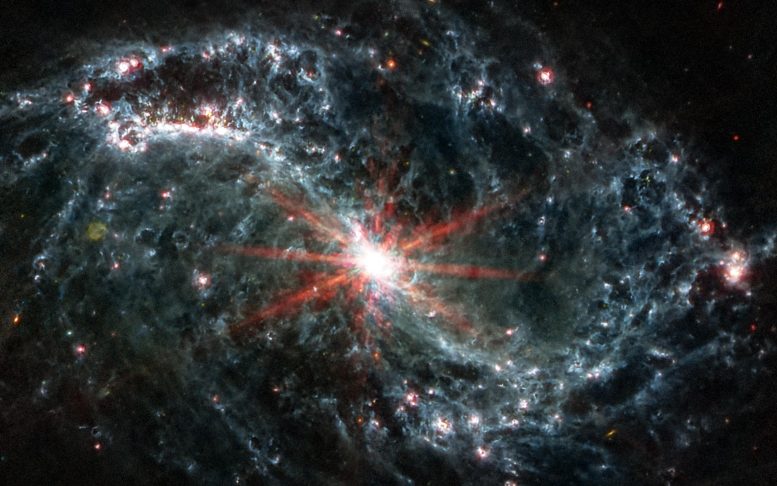
Scientists are getting their first look with NASA’s James Webb Space Telescope’s powerful resolution at how the formation of young stars influences the evolution of nearby galaxies. Webb MIRI image of NGC 7496, cropped and digitally enhanced. Credit: Science: NASA, ESA, CSA, Janice Lee (NOIRLab), Image Processing: Joseph DePasquale (STScI)
Young stars’ impact on galaxy evolution explored with PHANGS program
The saying goes, ‘From a tiny acorn grows the mighty oak.’ This is accurate not just here on Earth, but in our solar system and beyond. Even on a galactic scale, where individual stars and star clusters can sculpt a galaxy’s overall structure. Scientists say NASA’s James Webb Space Telescope is perfectly primed to study these phenomena, and the first data is astounding astronomers.
New imagery from Webb’s Mid-Infrared Instrument is revealing never-before-seen details into how young, newly forming stars influence the structure of the gas and dust of nearby galaxies, and therefore how they evolve over time. Areas of galaxies that once appeared dim and dark in visible light, now under Webb’s infrared eye, are glowing cavities and huge cavernous bubbles of gas and dust.
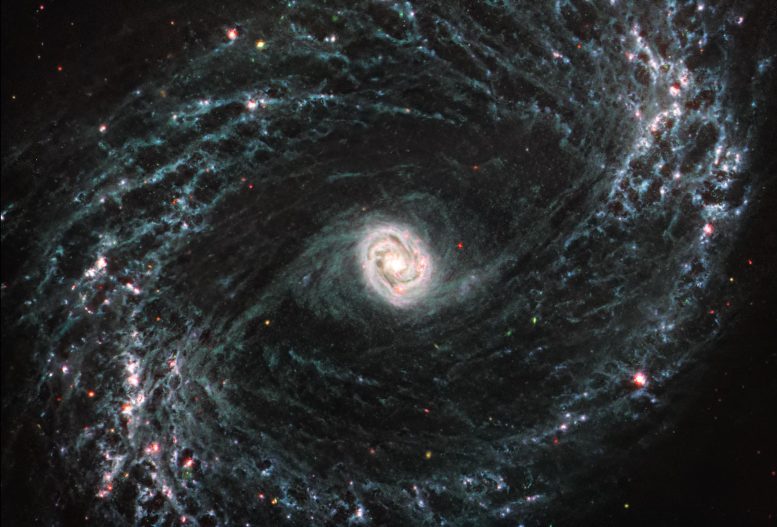
This image taken by NASA’s James Webb Space Telescope shows one of a total of 19 galaxies targeted for study by the Physics at High Angular resolution in Nearby Galaxies (PHANGS) collaboration. Nearby barred spiral galaxy NGC 1433 takes on a completely new look when observed by Webb’s Mid-Infrared Instrument (MIRI).
NGC 1433’s spiral arms are littered with evidence of extremely young stars releasing energy and, in some cases, blowing out the gas and dust of the interstellar medium. Areas that appear dark and dim in optical imaging light up under Webb’s infrared eye. This is due to clumps of dust and gas in the interstellar medium absorbing the light from forming stars and emitting it back out in the infrared.
Webb’s image of NGC 1433 is a strong display of how dynamic processes associated with forming stars influence the larger structure of an entire galaxy.
At the center of the galaxy, a tight, bright core featuring a unique double ring structure shines in exquisite detail with Webb’s extreme resolution. In this case, that ‘double ring’ is actually tightly wrapped spiral arms that wind into an oval shape along the galaxy’s bar.
NGC 1433 is a Seyfert galaxy, which are typically relatively close to Earth and has a supermassive black hole at the center eating material at a high rate. The brightness and lack of dust in the MIRI image of NGC 1433 could hint at a recent collision with another galaxy.
NGC 1433 lies over 46 million years away from Earth in the constellation Horologium.
Credit: Science: NASA, ESA, CSA, Janice Lee (NOIRLab), Image Processing: Alyssa Pagan (STScI)
Webb Space Telescope Reveals Intricate Networks of Gas and Dust in Nearby Galaxies
Researchers using NASA’s James Webb Space Telescope are getting their first look at star formation, gas, and dust in nearby galaxies with unprecedented resolution at infrared wavelengths. The data has enabled an initial collection of 21 research papers that provide new insight into how some of the smallest-scale processes in our universe – the beginnings of star formation – impact the evolution of the largest objects in our cosmos: galaxies.
The largest survey of nearby galaxies in Webb’s first year of science operations is being carried out by the Physics at High Angular resolution in Nearby Galaxies (PHANGS) collaboration, involving more than 100 researchers from around the globe. The Webb observations are led by Janice Lee, Gemini Observatory chief scientist at the National Science Foundation’s NOIRLab and affiliate astronomer at the University of Arizona in Tucson.
The team is studying a diverse sample of 19 spiral galaxies, and in Webb’s first few months of science operations, observations of five of those targets – M74, NGC 7496, IC 5332, NGC 1365, and NGC 1433 – have taken place. The results are already astounding astronomers.
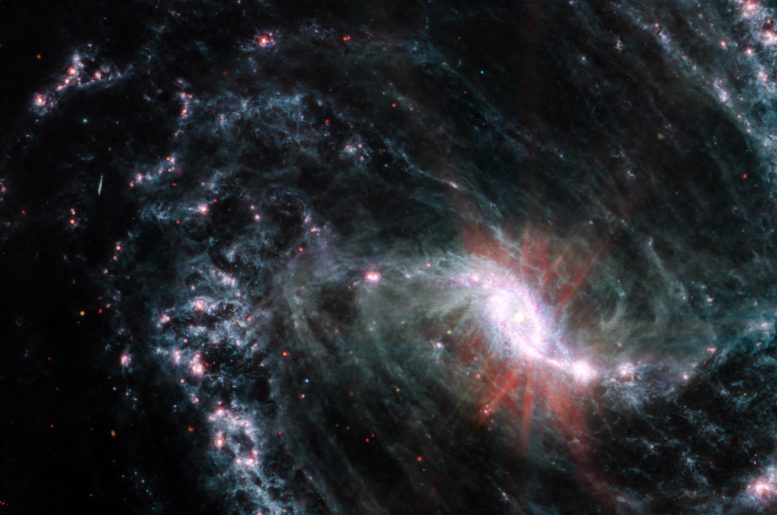
NGC 1365, observed here by Webb’s Mid-Infrared Instrument (MIRI), is one of a total of 19 galaxies targeted for study by the Physics at High Angular resolution in Nearby Galaxies (PHANGS) collaboration.
In the MIRI observations of NGC 1365, clumps of dust and gas in the interstellar medium have absorbed the light from forming stars and emitted it back out in the infrared, lighting up an intricate network of cavernous bubbles and filamentary shells created by young stars releasing energy into the galaxy’s spiral arms.
The exquisite resolution from Webb also picks up several extremely bright star clusters not far from the core and newly observed, recently formed clusters along the outer edges of the bar connecting to the spiral arms, only visible with Webb due to the thick dust in this region.
Additionally, the Webb images provide insights into how the orbits of stars and gas vary depending on where they form, and how this results in the population of older clusters outside the inner star-formation ring.
NGC 1365 is a double-barred spiral galaxy that lies about 56 million light years away from Earth in the constellation Fornax. It’s one of the largest galaxies currently known to astronomers, spanning twice the length of the Milky Way across.
Credit: Science: NASA, ESA, CSA, Janice Lee (NOIRLab), Image Processing: Alyssa Pagan (STScI)
“The clarity with which we are seeing the fine structure certainly caught us by surprise,” said team member David Thilker of Johns Hopkins University in Baltimore, Maryland.
“We are directly seeing how the energy from the formation of young stars affects the gas around them, and it’s just remarkable,” said team member Erik Rosolowsky of the University of Alberta, Canada.
The images from Webb’s Mid-Infrared Instrument (MIRI) reveal the presence of a network of highly structured features within these galaxies – glowing cavities of dust and huge cavernous bubbles of gas that line the spiral arms. In some regions of the nearby galaxies observed, this web of features appears built from both individual and overlapping shells and bubbles where young stars are releasing energy.
“Areas which are completely dark in Hubble imaging light up in exquisite detail in these new infrared images, allowing us to study how the dust in the interstellar medium has absorbed the light from forming stars and emitted it back out in the infrared, illuminating an intricate network of gas and dust,” said team member Karin Sandstrom of the University of California, San Diego.
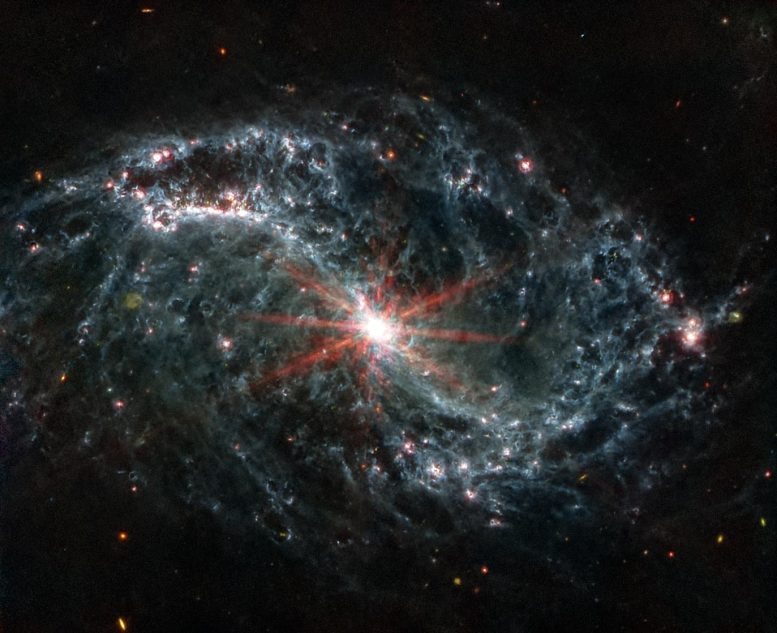
The spiral arms of NGC 7496, one of a total of 19 galaxies targeted for study by the Physics at High Angular resolution in Nearby Galaxies (PHANGS) collaboration, are filled with cavernous bubbles and shells overlapping one another in this image from Webb’s Mid-Infrared Instrument (MIRI). These filaments and hollow cavities are evidence of young stars releasing energy and, in some cases, blowing out the gas and dust of the interstellar medium surrounding them.
Until Webb’s high resolution at infrared wavelengths came along, stars at the earliest point of the lifecycle in nearby galaxies like NGC 7496 remained obscured by gas and dust. Webb’s specific wavelength coverage allows for the detection of complex organic molecules called polycyclic aromatic hydrocarbons, which play a critical role in the formation of stars and planets. In Webb’s MIRI image, these are mostly found within the main dust lanes in the spiral arms.
In their analysis of the new data from Webb, scientists were able to identify nearly 60 new, embedded cluster candidates in NGC 7496. These newly identified clusters could be among the youngest stars in the entire galaxy.
At the center of NGC 7496, a barred spiral galaxy, is an active galactic nucleus (AGN). AGN is another way to refer to an active supermassive black hole that is emitting jets and winds. This glows quite brightly at the center of the Webb image. Additionally, Webb’s extreme sensitivity also picks up various background galaxies, which appear green or red in some instances.
NGC 7496 lies over 24 million light-years away from Earth in the constellation Grus.
Credit: Science: NASA, ESA, CSA, Janice Lee (NOIRLab), Image Processing: Joseph DePasquale (STScI)
The high-resolution imaging needed to study these structures has long evaded astronomers – until Webb came into the picture.
“The PHANGS team has spent years observing these galaxies at optical, radio, and ultraviolent wavelengths using NASA’s Hubble Space Telescope, the Atacama Large Millimeter/Submillimeter Array, and the Very Large Telescope’s Multi Unit Spectroscopic Explorer,” added team member Adam Leroy of the Ohio State University. “But, the earliest stages of a star’s lifecycle have remained out of view because the process is enshrouded within gas and dust clouds.”
Webb’s powerful infrared capabilities can pierce through the dust to connect the missing puzzle pieces.
For example, specific wavelengths observable by MIRI (7.7 and 11.3 microns) and Webb’s Near-Infrared Camera (3.3 microns) are sensitive to emission from polycyclic aromatic hydrocarbons, which play a critical role in the formation of stars and planets. These molecules were detected by Webb in the first observations by the PHANGS program.
Studying these interactions at the finest scale can help provide insights into the larger picture of how galaxies have evolved over time.
“Because these observations are taken as part of what’s called a treasury program, they are available to the public as they are observed and received on Earth,” said Eva Schinnerer of the Max Planck Institute for Astronomy in Heidelberg, Germany, and leader of the PHANGS collaboration.
The PHANGS team will work to create and release data sets that align Webb’s data to each of the complementary data sets obtained previously from the other observatories, to help accelerate discovery by the broader astronomical community.
“Thanks to the telescope’s resolution, for the first time we can conduct a complete census of star formation, and take inventories of the interstellar medium bubble structures in nearby galaxies beyond the Local Group,” Lee said. “That census will help us understand how star formation and its feedback imprint themselves on the interstellar medium, then give rise to the next generation of stars, or how it actually impedes the next generation of stars from being formed.”
The research by the PHANGS team is being conducted as part of General Observer program 2107. The team’s initial findings, comprised of 21 individual studies, were recently published in a special focus issue of The Astrophysical Journal Letters.
The James Webb Space Telescope is the world’s premier space science observatory. Webb will solve mysteries in our solar system, look beyond to distant worlds around other stars, and probe the mysterious structures and origins of our universe and our place in it. Webb is an international program led by NASA with its partners, ESA (European Space Agency), and CSA (Canadian Space Agency).


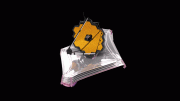
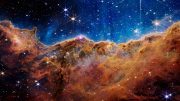
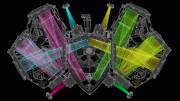
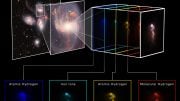
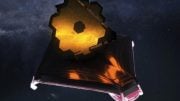
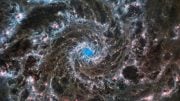
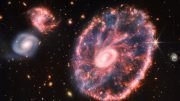
It is to bad we can’t get images from a number of different perspective angles maybe gravitational lensing or reflective imaging revealing a three dimensional image. this may show a observation of interest.